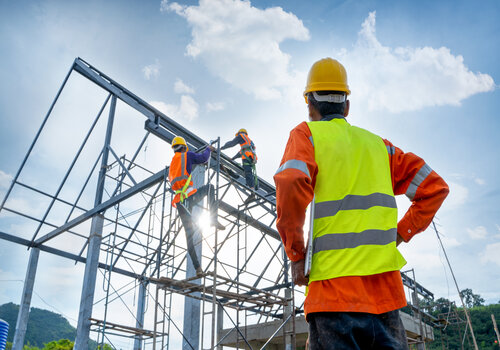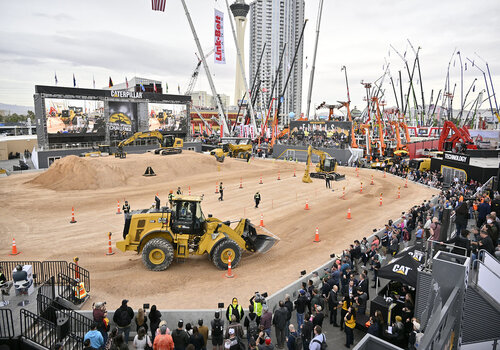If you have been working around construction equipment you have probably heard of the “Equipment Triangle,” a philosophy that is one of the fundamental tenets of the Association of Equipment Management Professionals (AEMP). The theory behind the equipment triangle is that all transactions between end users, distributors, and OEM/suppliers should be a win-win for all parties. However, with major changes in the construction equipment industry underway, dealerships and manufacturers will need to adapt to keep the Equipment Triangle in balance. We asked industry thought leaders to share their views of what the future holds:
1. Online sales and online rentals will increase significantly
In 2021 online sales of automobiles reached 30% of the market, their highest level. In July 2022, Ford announced it would move sales of its electric vehicles online at a fixed price, following Volvo and Tesla. “Whatever happens in the auto industry, is coming to construction equipment dealerships,” says Garry Bartecki, CFO of a Top 100 rental company and former CFO of the Associated Equipment Distributors (AED).
In a 2021 study from McKinsey & Company, sponsored by AED, more than 40 percent of off-highway dealers surveyed think it is very likely or somewhat likely that the OEM(s) they represent will implement a direct-to-consumer model within five years. They expect fully digital sales (including the actual purchase) for new equipment to increase from 7 percent to 29 percent and digital rentals to increase from 7 percent to 33 percent within five years.
“We definitely see things moving in this direction,” says Jefferson Yin, Director of New Business Models and Commercial Intelligence at Volvo Construction Equipment. In 2020, the company began allowing customers to pre-order new electric equipment online, and they recently launched an online configuration tool for those machines, which allows customers to “build and price” their ideal model.
“Because of how specific customer needs can be when buying construction machines, we get the requests at a corporate level and pass them along to the appropriate dealers for fine-tuning the commercial offer,” adds Yin.
“OEMs have always kept the major accounts,” says Bob Henderson, Vice President of Associated Equipment Distributors. While he agrees online sales will accelerate, he believes dealers will remain an integral part of the channel and a strategic partner.
“Dealers have to engage in online sales, to meet customer demand for the right pricing, reliable and durable equipment, and a warranty,” says Henderson. “They need business systems to meet those demands, in partnership with the OEMs.”
“There will still be transportation, delivery, and service, but it will be much more efficient,” explains Steve Clegg, Managing Director and Owner of Winsby, Inc., a business development firm with many clients in the construction equipment industry.
“Even for machine maintenance, we have heard it directly from customers and have seen rental houses and smaller equipment distributors building up their e-commerce options,” says Yin. “Customers like the convenience of e-commerce, but at the same time, they still want real people – like those at their dealership – available to answer their questions and provide support and service both before and after they buy or rent a machine. Finding the right balance between online convenience with the personal customized approach is key for all manufacturers and dealers.”
“Dealers are behind the curve and contractors are ahead of the curve when it comes to utilizing the Internet,” says Ron Slee, Managing Director Learning Without Scars, a training resource for dealers. The shift to e-commerce creates what he calls “the Amazon effect,” which means dealers will have to transition from selling things to selling services.
With brand differentiation waning in the heavy equipment market, Dale Hanna, CEO of Foresight Intelligence, a provider of business systems and telematics software, also believes the battle for customers will be based on customer experience. “Dealers need to adopt more technology to be able to serve more customers with the same amount of people or to attract better people,” he says.
The McKinsey study notes that despite anticipating a substantial increase in fully digital sales, only 14% of respondents listed digital sales among their biggest opportunities in the future of selling. The authors believe it is because dealers are still grappling with that new model and see other opportunities as more lucrative.
2. Electrification will disrupt the dealer’s revenue model
Electrification of construction equipment is in its early stages, but Grand View Research reports that the global off-highway electric vehicle market size is expected to reach $42.70 billion by 2030. Growth will be driven by lower operating costs as well as improved battery technology and lower costs for batteries. “You are going to see the whole industry switch to battery-operated or hybrid machines,” says Clegg. “The amount of parts drops by about 90 percent, so if your operating costs for a skid-steer were $20 an hour, that drops to $3 per hour.”
Dealers make their money on parts and services, and a high absorption rate (+85%) is a key focus. This metric is an indication of how well the margin from parts and services covers all the expenses of the dealership.
“Electric machines will cut the maintenance costs, so the dealers will make less money and the OEMS will make less money,” says Bartecki. “It’s a whole new ball game.”
To make up for the difference, dealerships will have to focus on new revenue sources. “Because they have the service expertise, I would recommend they move into supporting and servicing batteries, providing services such as recharging vehicles, tires, wear parts, and repair,” says Clegg. “They can also expand into different lines of equipment.”
According to Lars Arnold, Electromobility Product Manager for Volvo Construction Equipment, the company is working closely with dealers on sales and service training. The company has added electromobility training at its Hayward Training Center and has plans to include it at its new training center at the Shippensburg headquarters.
Autonomous machines are another potential revenue stream for dealers. “Autonomous machines, by their very nature, will require a higher level of technology and expertise,” says Hanna. “Is the dealer going to do more, or is the manufacturer?”
3. Connected machines and jobsites will continue to reduce owning and operating costs
Telematics can greatly reduce owning and operating costs. Nearly all new construction equipment machinery is equipped with technology that allows equipment owners and dealers to avoid downtime through preventative maintenance and early detection of mechanical issues. The challenge has been getting equipment owners on board. “Across the industry, adoption of telematics is definitely under 50%, and maybe only 30%,” says Henderson.
“The dealer has the trust of their customer, but they tend to be a single brand, while most customers have mixed fleets,” says Hanna.
Slee believes OEMs have tried to protect their own at the expense of the marketplace, but he’s starting to see some signs of change. “The machines need to be able to talk to each other as they do in other industries,” says Slee.
According to Jim Bretz, Director of Service and Solutions for Volvo Construction Equipment, about 60% of Volvo’s connected machines use the company’s advanced telematics system called ActiveCare Direct. These machines are monitored 24/7/365 for alarms that indicate an issue. Actionable information (an ACD case) is then sent directly to the customer’s equipment manager and the local dealer within minutes. Included is information that will help the customer address the issue without the help of a dealer. In addition, fleet reports are driving a change to the dealer’s business processes. “It gives them a tool to proactively consult with customers and help them evaluate and improve machine operation and maintenance,” says Bretz.
“The dealer has an opportunity to get geared up,” says Henderson. In the McKinsey study, analytics use cases from customer data (eg, upselling opportunities based on customer background) were cited by 51% of dealers as the biggest selling opportunity.
Henderson believes equipment buyers will demand to see a return on investment. “Sales need to be data-driven and that takes a different set of skills,” says Henderson. “Dealers need to show all that they can do to minimize expenses and maximize productivity.”
4. Technology will bring greater efficiency to parts and service
Parts are the bread and butter of a dealership, but for an end-user, buying parts is anything but easy. When a machine is down, the costs are astounding and end-users and rental dealers are likely to pay a premium to get a quality part as quickly as possible. Buyers often need guidance, and that may mean multiple phone calls and texts from multiple sources, including OEM and aftermarket parts dealers. Each part of the distribution chain has its own distribution, logistics, and markup.
According to Slee, OEM dealer market share for parts has dropped to 35-40%, about half of what it once was. Buyers today simply have more options, including Amazon.
Luke Powers, CEO of Gearflow, a web-based platform designed to work within the Equipment Triangle to facilitate the sale of parts, believes dealers will soon be competing directly with Amazon. “MRO supplies are the first entry point of Amazon coming into the industrial markets,” says Powers. “Amazon wants all procurement to be done on its platform regardless of the industry. Private-label brands in the construction equipment industry are the logical next step after adding MRO to their selection.”
Powers wants to take the inefficiencies out of buying OEM and aftermarket heavy equipment parts, and for that he created the Gearflow platform with Co-Founder Ben Preston, to make it easier for suppliers and end-users to work with each other. The platform provides one location for end-users to request parts from their existing suppliers or discover new ones, access their past parts order history paired to their machines, as well as centralize invoicing and reporting across their mixed fleet.
“The No. 1 way dealers lose customers is through miscommunication,” says Powers. A messaging center keeps communications tied to each part’s request and order, in a central location. “We’re trying to automate as much of the process as we can,” he says, “which ultimately will allow end-users and dealers to focus more on productivity and service.
Technologies such as Hive Quick Response will make service more efficient. The company places encrypted decals with unique identifiers on each piece of equipment. These include model and serial numbers, GPS location, and other vital information. When equipment needs service, the user scans the code with an app to begin the service process. Technicians have everything they need to complete the service request.
Being in close proximity to customers provides dealers with an advantage in parts and service. “Most dealers don’t retain customers beyond 40 miles,” says Clegg. The ability to print parts on demand via 3D printing could be a capability that dealers use to their advantage. “More and more will be produced and delivered locally,” he says,
5. Rental continues to grow, while an Equipment-as-a-Service model draws interest
Rental is expected to continue its upward trajectory fueled by higher prices for construction machinery and rising interest rates. According to the America Rental Association, construction equipment rental revenue is expected to increase 12.5% in 2022 to surpass $41.6 billion, with growth slowing to 7% in 2023, 2% in 2024, 3%in 2025 and 3% in 2026.
The concept of equipment-as-a-service, which would transfer responsibility for equipment to the manufacturer or dealer, allowing customers to focus on their core business, is also gaining interest. Unlike equipment rental, it might involve an entire fleet to be provided for several years with the potential to tie invoicing directly to usage.
Slee believes the concept has potential. “Contractors use the machine to dig a hole. They are only interested in the hole, and they look at the equipment merely as an operating cost,” he says.
Volvo CE is currently exploring the concept. “One of the most positive aspects from a customer perspective is the payment flexibility that this model offers since it’s usually linked to machine utilization,” says Dr. Ray Gallant, Vice President of Product Management and Productivity for Volvo Construction Equipment. This would allow companies with seasonal operations to match equipment expenses with revenues.
“It’s a very customized offer and it requires that the OEM, dealer, and customer are aligned so the fleet performs accordingly and delivers the expected results,” says Gallant.
Change is coming fast
Change typically accelerates in the face of headwinds, whether it is a pandemic, inflation, or high-interest rates. Dealerships that want to succeed moving forward need to prepare for change and that means gearing up with the people, technology, and services the market demands.
Read Next
6 Concrete Paving Trends Innovating the Industry
The Latest Trends in Telehandlers to Improve Your Bottom Line












